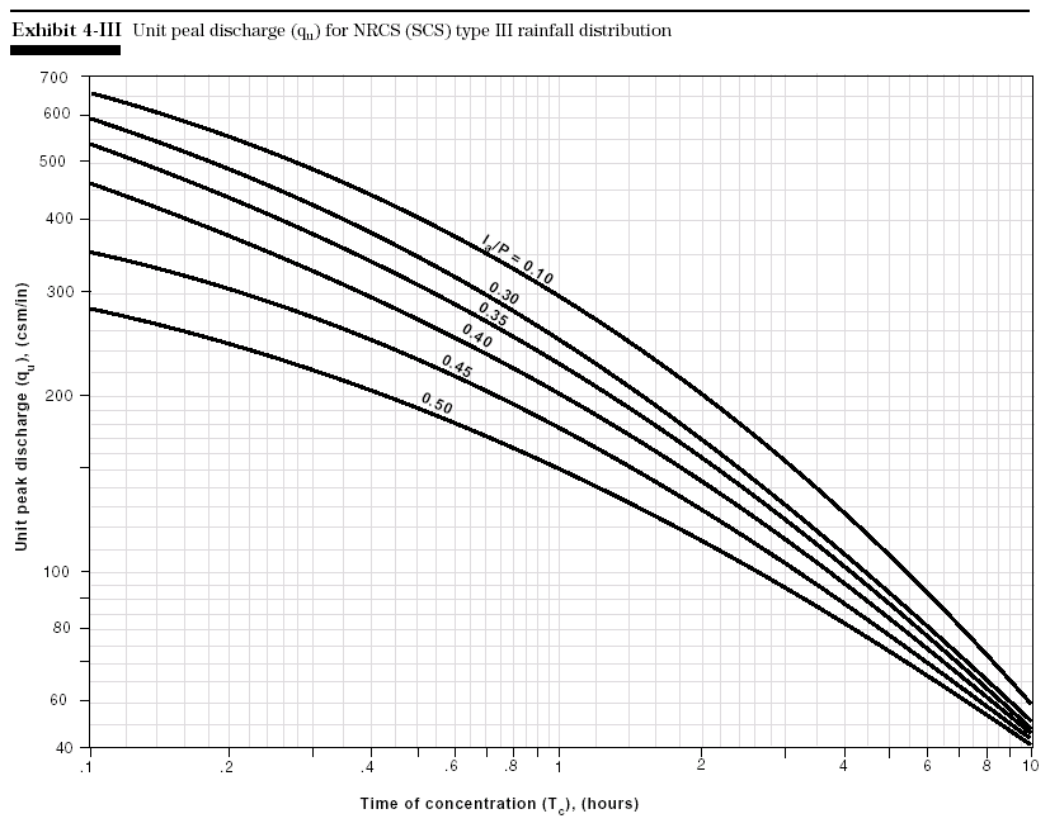Water Quality Flow Calculation
The water quality flow (WQF) is the peak flow rate associated with the water quality design storm. This section describes the recommended procedure for calculating the water quality flow (WQF) for the design of:
- Grass drainage channels (not water quality swales, which should be designed based on water quality volume - WQV)
- Pre-manufactured stormwater treatment devices (e.g., hydrodynamic separators, catch basin inserts, and media filters)
- Flow diversion structures for off-line stormwater treatment practices.
The WQF should be calculated using the WQV described in Chapter Seven. This WQV, converted to watershed inches, should be substituted for the runoff depth (Q) in the Natural Resources Conservation Service (formerly Soil Conservation Service), TR-55 Graphical Peak Discharge Method. The procedure is based on the approach described in Claytor and Schueler, 1996.
1. Compute the NRCS Runoff Curve Number (CN) using the following equation, or graphically using Figure 2-1 from TR-55 (USDA, 1986) (reproduced below):

where: CN = Runoff Curve Number
P = design precipitation, inches
(1” for water quality storm)
Q = runoff depth (in watershed inches)


2. Compute the time of concentration (tc) based on the methods described in Chapter 3 of TR-55. A minimum value of 0.167 hours (10 minutes) should be used. For sheet flow, the flow path should not be longer than 300 feet.
3. Using the computed CN, tc, and drainage area (A) in acres, compute the peak discharge for the water quality storm (i.e., the water quality flow [WQF]), based on the procedures described in Chapter 4 of TR-55.
- Read initial abstraction (Ia) from Table 4-1 in Chapter 4 of TR-55 (reproduced below); compute Ia/P

- Read the unit peak discharge (qu) from Exhibit 4-III in Chapter 4 of TR-55 (reproduced below) for appropriate tc

- Substituting the water quality volume (WQV), converted to watershed inches, for runoff depth (Q), compute the water quality flow (WQF) from the following equation:

where: WQF = water quality flow (cfs)
qu = unit peak discharge (cfs/mi2/inch)
A = drainage area (mi2)
Q = runoff depth (in watershed inches)

Other peak flow calculation methods may be used for determining the WQF, such as those recommended by manufacturers of proprietary treatment systems, provided that the WQF calculated by other methods is equal to or greater than the WQF calculated using the above NRCS Graphical Peak Discharge Method.
Flow Diversion Structures
Flow diversion structures, also called flow splitters, are designed to deliver flows up to the design water quality flow (WQF) or water quality volume (WQV) to off-line stormwater treatment practices. Flows in excess of the WQF or WQV are diverted around the treatment facility with minimal increase in head at the flow diversion structure to avoid surcharging the treatment facility under higher flow conditions. Flow diversion structures are typically manholes or vaults equipped with weirs, orifices, or pipes to bypass excess runoff. A number of design options exist. Figures B-1 through B-3 show common examples of flow diversion structures for use upstream of stormwater treatment practices. Other equivalent designs that achieve the result of diverting flows in excess of the WQF or WQV around the treatment facility, including bypasses or overflows located inside the facility, are also acceptable.
The following general procedures are recommended for design of flow diversion structures:
- Locate the top of the weir or overflow structure at the maximum water surface elevation associated with the WQF, or the water surface elevation in the treatment practice when the entire WQV is being held, whichever is higher.
- Determine the diversion structure dimensions required to divert flows in excess of the WQF using standard equations for a rectangular sharp-crested weir, uniform flow in pipes or channels, or orifice depending on the type of diversion structure.
- Provide sufficient freeboard in the stormwater treatment practice and flow splitter to accommodate flow over the diversion structure.
- Limit the maximum head over the flow diversion structure to avoid surcharging the stormwater treatment practice under high flow conditions. Flow to the stormwater treatment practice at the 100-year water surface elevation should not increase the WQF by more than 10 percent.
- Design diversion structures to withstand the effects of freezing, frost in foundations, erosion, and flotation due to high water conditions. These structures should be designed to minimize clogging potential and to allow for ease of inspection and maintenance.



References
U.S. Department of Agriculture, Natural Resources Conservation Service (formerly Soil Conservation Service), Urban Hydrology for Small Watersheds, Technical Release No. 55, Washington, D.C., June 1986.
Claytor, R.A. and T.R. Schueler, Design of Stormwater Filtering Systems, The Center for Watershed Protection, Silver Spring, Maryland, December 1996.